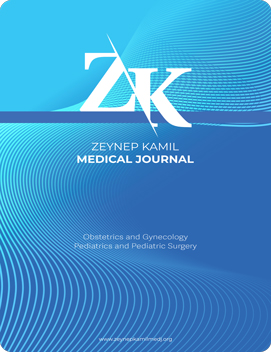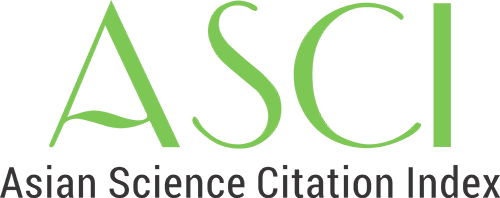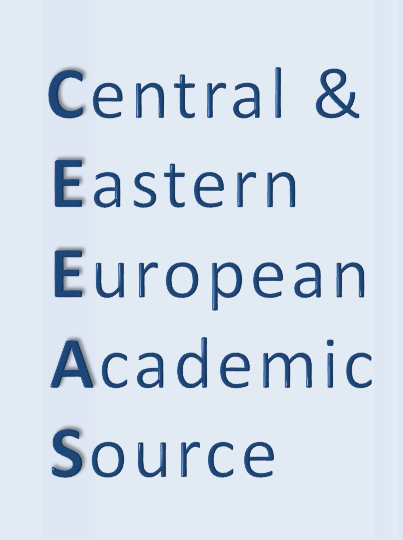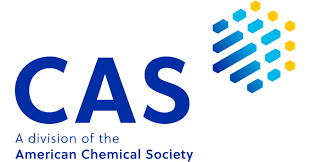Quick Search
Volume: 43 Issue: 2 - 2012
| ORIGINAL RESEARCH | |
| 1. | Preeklampside Genetik Trombofilik Belirteçler Mehmet Akif Sargın, Emel Asar Canaz, Ali Gedikbaşı, Hilmi Tozkır, Yavuz Ceylan Pages 38 - 45 INTRODUCTION: We aimed to investigate the relationship between preeclampsia and inherited thrombophilias such as MTHFR gene mutations, factor V Leiden mutations and prothrombin gene mutation; and to assess the significance of the relationship at mild, severe and early-onset preeclampsia. METHODS: 68 preeclamptic pregnants diagnosed between October 2008 and March 2010 according to the American College of Obstetrics and Gynecology (ACOG) guideline 2002, and 70 healty pregnant women who carried her pregnancy beyond term (37 weeks and after) without any complications and applied to Bakirkoy Maternity and Children Hospital were taken into study and control groups. 5 ml venous blood were taken from each women in both groups and genetic evaluation is done at laboratory. RESULTS: AFactor V Leiden, MTHFR C677T, and prothrombin homozygous or heterozygous mutations were not statistically different between preeclamptics and healty pregnants. Comparisons for the mutations between severe preeclampsia and control cases were not statistically different. Cases with early-onset preeclampsia that occured before 34 weeks and 28 weeks, and the preeclamptic cases complicated by IUGR, were also assessed separately and mutations were not statistically different between study and control cases. The ratio of having at least one mutation in healty patiens were 64 percent, and the most common mutation was MTHFR heterozygous polymorphism. DISCUSSION AND CONCLUSION: Although pregnancy complications, maternal and fetal morbidity and mortaliy was higher in severe preeclampsia; presence of thrombophilic gene mutations was not statistically different from healty pregnants. Because the association between preeclampsia and thrombophilia is unproven yet, using such genetic markers as routine screening for thrombophilia or prognostic tools is not recommended. |
| 2. | Makrozomik Gebeliklerin Doğum Şekilleri ve Sonuçları Mehmet Gül, Erbil Çakar, Oya Demirci, Oya Pekin, Hamdullah Sözen, Doğan Vatansever, Arif Aktuğ Ertekin Pages 46 - 52 INTRODUCTION: To evaluate the mode of deliveries and consequences of macrosomic pregnancies. METHODS: The birth records between 1 st of January 2006 and 31 st of december 2008 in Obstetric Clinic of Zeynep Kamil Womens Health and Children Diseases Education and Research Hospital, were rewieved retrospectively. Study group was composed of with bith weight 4000 g and above, and the control group was composed of with birth weight between 2500-3999 g randomly selected pregnancies at the same time period. RESULTS: According t he birth records between 1 st of January 20 06 and 31 st of december 2008 in Obstetric Clinic of Zeynep Kamil Womens Health and Children Diseases Education and Research Hospital, the insidance of macrosomia (≥ 4kg) was found as 5,15%. Ultrasound to predict the weight over 4000 grams, compared to normal birth weight infants were less successful. cpd, was the primary risk factor and indication for primary cesarean section. The duration of labour was longer and caeserean section rate was higher viewed in the cases with oxytocin infused and in macrosomic group. Shoulder dystocia was more prevalent in macrosomic infants and cases with diabetes. Uterine atony was only prevalent in macrosomic pregnancies. Fetal trauma, in the cases with shoulder dystocia and who delivered vaginally were more prevalent. The rate of perinatal mortality in the study group was 0.51%, and none in the control group DISCUSSION AND CONCLUSION: Estimated fetal weight with ultrasound in macrosomic group was less successful and cesarean section rate was high, and also in cases delivered vaginally shoulder dystocia and fetal trauma was more frequently observed in macrosomic group. |
| 3. | Gestasyonel Trofoblastik Hastalıklar ve Takip Oranları Özgür Aydın Tosun, Pınar Batu, Arzu Arınkan, Ertuğrul Yılmaz, Çetin Çam, Ateş Karateke Pages 53 - 57 INTRODUCTION: Gestational trophoblastic disease is a heterogeneous group of diseases characterized by invasion of abnormally proliferating trophoblastic tissue to the endometrium and myometrium. Diagnosis is histopathologically following vacuum curettage. Purpose of this research is to determine the follow-up ratio of patients who had GTD. METHODS: This retrospective study was performed including the patients who had GTH diagnosis at Zeynep Kamil Hospital between 2000 and 2008. Statistical analysis was performed using the SPSS 12 program. Chi-square test was used for statistical analysis. P values were considered to be statistically significant at P < 0.05. RESULTS: 103951 patients were included in this research. 257 of them had GTH diagnosis histopathologically. 5 of them (%1.94) had choriocarcinoma, 3 of them (%1.16) had placental site trophoblastic tumors and 249 of them (%96) had hydatidiform mole.62 of hydatidiform mole cases (%25) did not visit doctors regularly. This ratio is %21 at partial mole cases and %25 complete mole cases respectively. DISCUSSION AND CONCLUSION: Patients who had GTH diagnosis should be followed regularly. Regular follow up at specialized clinics is extremely important for the proper management of the disease. |
| CASE REPORT | |
| 4. | Postmenopozal Servikal Stenoza Sekonder Gelişen, Pelvik Kitleyi Taklit Eden Hematometra ve Yönetimi Hüseyin Pehlivan, Aşkın Evren Güler, Uğur Keskin, Hakan Çoksüer, Erhan Aktürk, Ali Ergün Pages 62 - 64 Haematometra is an important clinical problem as a result of obstruction of the lower genital tract under cervical canal and secondary accumulation of blood collects in the uterine cavity. In relation to the degree of distention pelvic pain can be companied to that problem. This condition may rarely be confused with other pathologies that cause pelvic mass such as pelvic abscess, ovarian tumors, ovarian torsion and torsion of the fallopian tube. In this paper a case where haematometra is mimicking an adnexal mass will be discussed. |
| 5. | Erken Başlangıçlı Maternal Rh İzoimmunizasyonu Nedenli Fetal Hidrops Olgusunun Başarılı Yönetimi; Olgu Sunumu Turhan Aran, Mehmet A. Osmanoğlu, Ipek Pekgöz, Hasan Bozkaya, Erbil Çakar Pages 65 - 68 Aim: to present a successfully managed fetal hydrops case due to maternal Rh alloimmunization and discuss early second trimester fetal red blood cell transfusion technique. Case: A Thirty-six year old woman with immunized Rh and fetal hydrops was assessed at our perinatology department. There were three previous pregnancy losses because of fetal hydrops in her obstetric history. In obstetric doppler scan, fetal middle cerebral artery peak systolic velocity was greater than 1.5 MoM. Cordosynthesis was offered to family. Fetal haemoglobin was 3gr/dl. Concomitant red blood cell transfusion was performed due to severe fetal anemia. We planned to reach targeted hematocrit level with two transfusions in a week interval. Repeated transfusions were performed at 24th, 27th and 31st week. 2330 gr. neonate with 9/10 APGAR was delivered with cesarean section. Hemoglobin concentration of newborn was 8.7gr/dl at time of delivery. Postpartum cranial MRI scanning and neurological findings were unremarkable. Healthy newborn was discharged. Conclusion: Early second trimester fetal red blood cell transfusion was technically difficult. Reaching targeted hematocrit level with interval transfusions should be kept in mind in severely anemic fetuses because early second trimester transfusion may cause fetal hemodynamic alterations and fetal death |
| ORIGINAL RESEARCH | |
| 6. | Primer Konjenital Glokomda Trabekülotomi ile Kombine Mitomisinli Trabekülektomi Sonuçlarımız Serhat Imamoğlu, Mehmet Şahin Sevim, Gökhan Pekel, Hüseyin Avni Sanisoğlu Pages 69 - 73 INTRODUCTION: To evaluate the effectiveness of combined trabeculotomy-trabeculectomy with mitomycin C for primary congenital glaucoma METHODS: The medical records of 7 patients 13 eyes with primary congenital glaucoma who had combined trabeculotomy-trabeculectomy with mitomycin C were reviewed. SPSS 15.0 software for Windows® was used for statistical analysis. Preoperative and postoperative intraocular pressures were compared with Wilcoxon signed rank test. RESULTS: Thirteen eyes of 7 (4 male, 3 female; mean age 30.6 ± 22.4 months) patients who was operated between June 2006- May 2012 were included into the study. The mean time of first presantation was 2.6 ± 1.1 (1-4) months, whereas the mean time of first surgery was 5.3 ± 4.0 (1-12) months. Six patients had bilateral disease. Mean follow-up time was 25.9 ± 22.6 (1-54) months. Mean corneal horizontal diameter was 13.4 ± 0.9 (12-15) mm. Corneal edema was found in 53 % of the patients. The surgical success rate (intraocular pressure < 21 mm Hg) of eyes with combined surgery alone was 53.8 %, however this ratio was incresed to 76.9 % when additional surgeries were performed. DISCUSSION AND CONCLUSION: Even though combined trabeculotomy- trabeculectomy with mitomycin C is an effective surgical option for primary congenital glaucoma, the surgical success rate is increased with additional surgeries |
| CASE REPORT | |
| 7. | Hidrops Fetalisli Yenidoğanda Bilateral Akut Skrotum için Eksplorasyon Kararı Ne Kadar Yaşamsal? Gökmen Kurt, Ayşenur Cerrah Celayir, Koray Pelin, Oktav Bosnalı, Serdar Moralıoğlu Pages 74 - 77 Testicular torsion has a bimodal distribution, namely in the early neonatal period and in adolescent period. Internal spermatic artery is the longest artery of the human body. For that reason, it makes the testicle a good candidate to turn around its vascular pedicle. Neonatal testicular torsion is a difficult condition to diagnose and it is more difficult to make a decision to operate in obscure cases, especially with an accompanying systemic disease. A-40-hour old newborn with respiratory distress and Hydrops fetalis was consulted for abdominal distension, scrotal edema and swelling. On physical examination, there was no scrotal transluminiation, but both scrotal and inguinal region was tender with palpation in both sides. Both testicles were hard to palpation and situated in high-horizontal position. Right testicle was approximately 1x1 cm, and left testicle was approximately 2x2 cm in size. Plain abdominal xray was normal. Based on physical examination; the patient underwent immediate surgery with a diagnosis of bilateral testicular torsion. At the operation we found the left testicle was rotated 540 degree, and right one was rotated 720 degree on their pedicle. Both testes were detorsioned manually. After detorsion, suspicious viability on both testicle were identified and bilateral orchiopexy were performed. Two months after operation, color doppler ultrasound showed diminished but present testicular arterial flow. Since we mostly see emergency conditions after regular working-hours, especially in acute scrotum cases, we have to evaluate the patient without any spesific diagnostic tool like Color doppler Ultrasonography. However, any suspicion about testicular torsion should emerge the surgeon to perform surgical exploration to prevent testicular necrosis which its future consequences could be catastrophic for both patient and parents as seen in our case. |
















